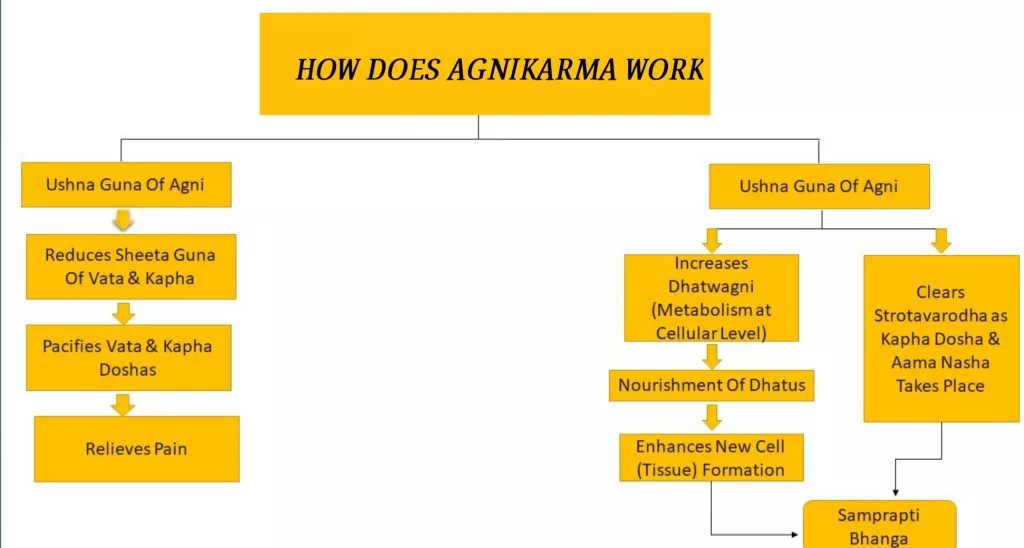Hello readers,
Ayurveda has described different ways of pain management. Agnikarma also known as dahankarma is a very unique and thousands of years old method among them. It has been practiced in India from the ancient time of Vedas. There are references of agnikarma in Atharvaveda and Rigveda also.
Agni (fire element) is of very much importance as it does refer not only to digestive fire (jatharagni) but also to the metabolic activities (dhatwagni). Agni is used as a source of treatment. For example –
· Agni when used in yadnya (a ritual where medicinal plants are burnt), purifies air by destroying microorganisms.
· Agni when used in the form of medicines (bheshaj) cures disease.
· Agni when used locally in agnikarma, relieves pain, act as a shock treatment (trasana chikitsa) in psychiatric disorders (manasaroga).
Ayurvedic scholars Charaka, Vagbhata have also described agnikarma. Sushruta, the surgeon, has dedicated a whole chapter for agnikarma (sootrasthana/12).
Let’s understand some basic facts about agnikarma.
1. Agnikarma is a procedure where a moderately heated probe is applied on the tender area.
2. Agnikarma is said to be useful in diseases incurable by medicines, ksharakarma and shastrakarma (surgery).
3. Disorders treated by agnikarma have no recurrence.
4. Amount of Agni to be used depends on the area of tenderness/disease and part involved (twak, mamsa, sira etc.)
5. Agni should be Nirdhooma (smoke free).
Different types of instruments are used for dahankarma according to the part involved. You can find them in the chart below.

Now a day probes are used largely. Different material used for probe (shalaka) has different significance.
- Loha(iron)/ tamra(copper)shalaka– used in corn
- Rajata(silver)shalaka- in early stage of fistula/abscess and in diseases above neck (urdhvajatrugata roga)
- Suvarna (gold) shalaka– used in nerve disorders and also for cosmetic purpose as it does not leave big mark.
- Mruttika (mud) shalaka- used on soles, in cases like corn, warts etc.
In general we can say that for degenerative diseases, gold/silver probes are used and in over growth iron probes are used. Even panchadhatu (alloy of gold, silver, copper, brass and iron) probe is preferred by some vaidyas.

How does agnikarma works
According to Ayurveda, vata is the root cause of all kind of pain is vata. There is no pain without vitiation of vata.
वातादृते नास्ति रुजा न पाक: पित्तादृते नास्ति कफाश्च पूयः……..
Su. So. 17/12.
Kapha vriddhi /aama nirmiti (aama is a toxic and sticky substance generated in the body as a result of improper digestion) causes stortorodha leading to further vitiation of vata.
So, main aim of this procedure is to reduce pain (reduce vata) and destroy aama.

Types of Agnikarma–
A. As per sadhan (instrument)used-
1. Snigdha – ghee and oils are used
2. Rooksha – solid instrument like probe, Pippali, Godanta are used.
B. As per mark on the skin/particular area-
1. Valaya (round)
2. Bindu (dot)
3. Vilekha(different types of lines)
4. Pratisarana(rubbing the probe)
5. Ardhachandra (half moon shape)
6. Swastika (a particular symbolic shape)
Procedure includes-
Poorva karma (work to be done prior to the procedure)-
· Explain patient about the procedure verbally as well as with help of photos.
· Take consent of the patient.
· Give picchila annapana (semisolid fatty food) except in cases like moodhgarbha, bhagandar,arsha and mukharoga(diseases of mouth) where agnikarmas to be done empty stomach.
· Clean area with triphala/ panchavalkal kwatha.
· Search and mark tender points.
· Cover surrounded unnecessary area.
Pradhana karma (actual procedure)-
· Heat the probe till red hot or till desired temperature.
· Apply on marked area off and on in desired shape. Never apply continuously
Pashchat karma (post procedure work)
· Immediately apply fresh Aloe Vera pulp/yashtimadhu ghrita or tailam on the affected part for soothing.
· Comfort patient by informing details about number of seating required, time for healing the wound, about the scar etc.
· Ask to apply ghee and honey on the site at home.
· Give follow up date for further assessment.
· Check for the signs of samyak dagdha i.e. proper burn.
Agnikarma should be done with proper care and calm mind as it can have complications like severe pain, excessive burnt tissue, ulceration, burning sensation, thirst, fever if not done properly.
It is an instantly beneficial procedure if done by expert vaidyas after proper diagnosis.










